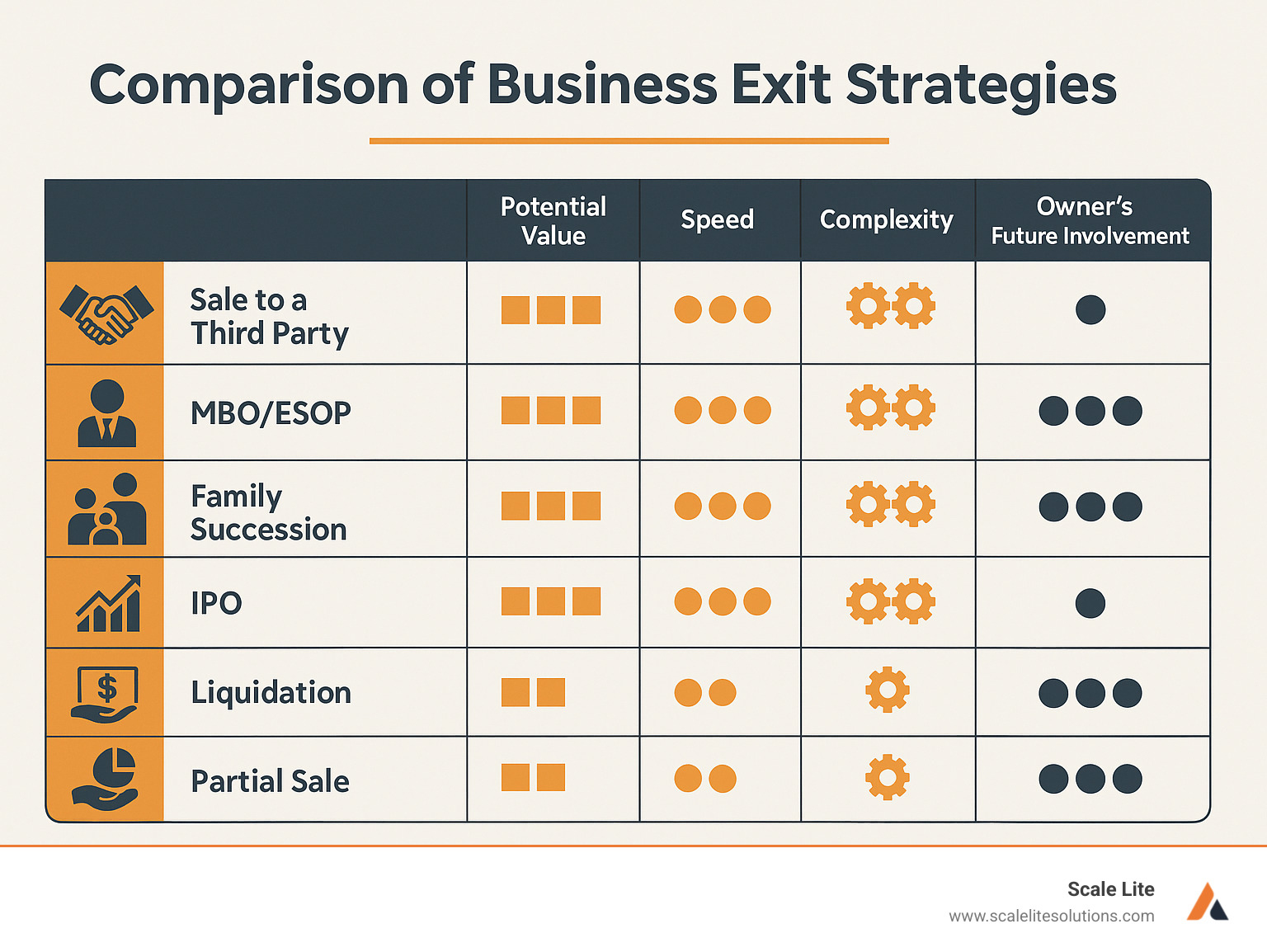
Exit Plans Demystified—Understanding the Meaning Behind the Buzzword

Why Understanding Exit Plan Definition Is Critical for Every Business Owner
An exit plan definition is a strategic roadmap for transitioning out of your company while maximizing its value. It's your blueprint for leaving the business on your own terms, whether through a sale, transfer, or closure.
Quick Answer: Exit Plan Definition
- What it is: A strategic plan for transitioning ownership of a business
- Purpose: Maximize value, minimize risk, ensure smooth transition
- Types: Sale to third party, family succession, employee buyout, IPO, liquidation
- Timeline: Should start 3-5 years before desired exit
- Key benefit: Transforms your business from owner-dependent to market-ready
Despite its importance, industry research shows that when asked "What is your exit plan?", most owners draw a blank. In fact, only 24% of UK business leaders have an exit strategy in place. This is concerning because every owner will eventually exit their company.
An exit plan isn't just for retirement; it's a tool for building value from day one. It forces you to create systems and reduce dependency on yourself, making your company stronger today and more valuable tomorrow. The statistics are sobering: only 2 in 10 businesses listed for sale actually sell, often because of poor planning, not poor performance.
I'm Keaton Kay, founder of Scale Lite. I've spent years in private equity helping owners prepare for successful transitions, and I've seen how a clear exit plan transforms business outcomes.

The Core of an Exit Plan Definition: More Than Just an Ending
An exit plan isn't about ending your business; it's a powerful tool for building a stronger, more valuable company today. It shifts your thinking from reactive to proactive, guiding strategic decisions that create long-term enterprise value, not just annual income. This is a critical mindset shift, yet only 24% of business leaders have an exit strategy in place, leaving their biggest financial asset to chance.
More info about a Business Exit Plan
What is a Business Exit Strategy?
A business exit strategy is your roadmap for transitioning ownership while maximizing value and minimizing risk. It's your plan for how you'll eventually liquidate your stake, whether that's cashing out with a profit or limiting losses. It's not just for retirement; it prepares you for new opportunities or unexpected life changes. By knowing your destination, you build a more intentional, valuable asset that someone else will want to own.
A scholarly look at savvy exit strategies
Why It's Crucial: Common Motives for Exiting
Owners exit for many reasons, and planning accommodates them all. Retirement is the top driver (75%), but burnout and stress also account for 22% of exits. Other common motives include:
- Pursuing new ventures
- Maximizing the return on investment
- Limiting losses in a struggling business
- Responding to unforeseen events like health issues or economic downturns
- Stepping back from daily operations without a clear successor
Exit planning is realistic. It prepares you to respond strategically to whatever comes next.
Exit Plan vs. Succession Plan: Understanding the Difference
Many confuse these two, but succession planning is just one piece of the larger exit planning puzzle.
Exit Planning is the comprehensive strategy for the owner leaving the business. It covers all financial, legal, and operational aspects to maximize the owner's value, considering all possible exit routes.
Succession Planning focuses specifically on who will lead the business after you. It's about identifying and preparing your replacement to ensure business continuity.
A succession plan is vital for a family transfer or management buyout. However, if you sell to a large corporation, they'll likely bring their own team, making streamlined operations and clean financials more important. With only 1 in 10 owners having a formal succession plan, many are thinking too narrowly. A full exit plan provides the flexibility to pursue the best path.
More on succession planning as planned behavior
Exploring Your Options: 6 Common Business Exit Strategies
When we talk about an exit plan definition, we're not talking about a single, one-size-fits-all solution. There are several paths you can take, each with its own benefits, challenges, and implications for your business and your future. Understanding these options is the first step toward choosing the right one for you.

To help you visualize, here's a quick comparison of the most common exit strategies:

Now, let's dive into each of these strategies in more detail.
1. Sale to a Third Party (Merger & Acquisition)
Selling to a third party is the most common exit route, with 49% of business owners choosing to sell to someone unrelated to their family. This classic "highest bidder" scenario typically involves two types of buyers:
- Strategic buyers: These are companies that see your business as a perfect fit for their existing operations, such as gaining your customer base or technology. They often pay premium prices for these synergies.
- Financial buyers: These are private equity firms or investment groups that view your business as a solid investment. They focus on your financials and growth potential, aiming to improve performance and sell for a profit later.
Maximizing your sale price requires extensive preparation. Buyers conduct rigorous due diligence, scrutinizing at least three years of clean financial statements, operational processes, and management team strength. They want to see a business that is systematized, scalable, and not dependent on you. This route often provides the cleanest break but requires planning 3-5 years in advance to command top dollar.
2. Management or Employee Buyout (MBO/ESOP)
Sometimes the best buyer is already on your team. Selling to your management or employees is a rewarding path chosen by 23% of owners, as it preserves your legacy and company culture under familiar leadership.
- A Management Buyout (MBO) involves your current leadership team purchasing the business, often with external financing.
- An Employee Stock Ownership Plan (ESOP) allows a broader group of employees to gain ownership through a qualified retirement plan, turning your workforce into partners.
The biggest hurdle is often financing, as your team may lack the personal wealth for an immediate purchase. This can make the process longer than a third-party sale. However, the benefits of continuity and preserving what you've built make it a worthwhile option, provided you have a strong management team and the business can support the buyout debt.
3. Family Succession
Passing your life's work to the next generation is an emotionally appealing exit, with 24% of owners in Ontario selling to a family member. This path is about preserving a family heritage, which is both its greatest strength and biggest challenge.
Family succession requires immense planning to steer complex family dynamics, estate tax implications, and honest assessments of the successor's capabilities. The sobering reality, as research from the Saylor Academy notes, is that very few family firms survive beyond the first generation, often due to a lack of proper planning.
Success requires starting early and having difficult conversations about interest and ability. Ensuring the right person leads the business forward is essential for preserving its legacy.
Estate tax issues for family businesses
4. Initial Public Offering (IPO)
An Initial Public Offering (IPO) is the most glamorous exit, involving selling shares on a public stock exchange. However, it's an exceptionally complex, costly, and rare path, suitable for only a handful of businesses.
The process is staggering, costing millions in fees and taking 12-18 months of intense preparation. Once public, your company faces strict regulatory oversight under laws like the Sarbanes-Oxley Act and a significant loss of control as you become accountable to public shareholders.
With only around 200 IPOs in the U.S. in a typical year, this route is unrealistic for most service businesses. It's best suited for high-growth companies with massive market potential, like tech or biotech firms. For most owners, the other strategies are far more practical.
5. Liquidation (Winding Down)
Liquidation isn't always a sign of failure. While it can be a forced outcome of bankruptcy, it can also be a strategic choice. Liquidation involves closing the business, selling its assets, and paying off debts.
Surprisingly, up to one-third of businesses that close were successful at termination. Many profitable owners choose this path for its simplicity, especially if their business is hard to transfer (like a personal consultancy) or they lack a buyer. A planned liquidation gives you control over the process.
Another approach is gradual liquidation, where you slowly wind down operations over time, taking profits out instead of reinvesting them. While liquidation may not maximize value like a sale, it offers a straightforward, certain, and clean break without the stress of negotiations or due diligence.
6. Partial Sale or Strategic Partnership
A partial sale offers a middle ground for owners not ready for a full exit. In this scenario, you sell a minority stake (typically 20-49%) while retaining control and staying involved. This can provide capital for growth or allow you to diversify your personal wealth without giving up the business you built.
A strategic partnership takes this further, aligning you with a partner who brings complementary strengths, such as distribution channels or technology. The financial investment is secondary to the strategic value.
This approach offers flexibility and can be a stepping stone to a full exit. Many owners use a minority partner to help scale the business, leading to a much higher valuation when they sell the entire company years later.
How to achieve operational excellence for a partnership
Building Your Blueprint: Key Steps to an Effective Exit Plan
Creating an effective exit plan definition requires a solid blueprint and the right team. This process isn't just about preparing to leave; it's about making your business stronger and more valuable today.

More info about Data-Driven Business Strategy
Step 1: Define Your Personal and Financial Goals
First, clarify what you want your life to look like after the exit. Consider your financial targets (ideal sale price), desired involvement level post-sale (clean break or consulting), future lifestyle, and legacy concerns (preserving jobs or maximizing profit).
Step 2: Determine Your Business's Value (and How to Increase It)
Understand what your business is worth today to identify opportunities for growth. Value includes tangible assets (equipment, property) and, more importantly, intangible assets like brand reputation and customer loyalty. A business valuation specialist, such as one certified by NACVA, can provide an accurate assessment. From there, you can systematically improve operations to increase both your profits and the multiple a buyer will pay.
More info about Business Value Improvement
Step 3: Make the Business Less Dependent on You
If your company can't run without you, you own a job, not a sellable business. Buyers want turnkey operations. Achieve this by:
- Building strong systems: Document all key processes so anyone can follow them.
- Developing your management team: Empower others to make decisions and solve problems.
- Using smart automation: Implement technology for routine tasks like scheduling and invoicing.
More info about Businesses That Run Themselves
Step 4: Assemble Your Team of Advisors
You wouldn't build a house without experts, and you shouldn't plan an exit alone. Your team should include:
- Financial advisors for tax planning.
- Legal counsel to handle contracts and compliance.
- Accountants to prepare clean financial statements.
- Business brokers or M&A advisors to manage the sale.
- Certified Exit Planning Advisors (CEPA) to coordinate the entire process.
Navigating the Pitfalls: Common Mistakes and How to Avoid Them
The road to a successful exit is filled with potential pitfalls. A sobering statistic reveals that only 2 out of 10 businesses listed for sale actually close a transaction, and half of those require major seller concessions. Most of these failures stem from avoidable mistakes.

Mistake 1: Starting Too Late
This is the biggest mistake. Treating your exit plan like a last-minute task can slash your sale price by 30-50%. As The TGG blog states, "The best time to develop an exit plan is now." The ideal planning window is 3-5 years before your departure. This gives you time to build value, clean up financials, and wait for favorable market conditions.
Mistake 2: Underestimating the Business's True Value
Owners often undervalue their business by focusing on physical assets and ignoring intangible goldmines like brand reputation and customer loyalty. This mistake is compounded by poor financial records and undocumented processes. Buyers conduct intense due diligence; without clean, organized documentation, deals fall apart or sale prices plummet.
More info about how to Improve Business Operations
Mistake 3: Neglecting the Human Element
An exit is a major human event. Poor communication can cause key employees to leave, sinking your business's value. As an Ontario law firm blog advises, you should keep employees appropriately updated. Furthermore, failing to create a transition plan for the new owner or prepare for the emotional toll of exiting can lead to a chaotic handover and personal regret.
Frequently Asked Questions about the Exit Plan Definition
Here are answers to the most common questions we hear from business owners about exit planning.
When is the best time to start creating an exit plan?
The best time is now, regardless of your timeline. Thinking like a buyer from day one helps you build a stronger, more valuable business. Serious, detailed planning should begin 3-5 years before your desired exit. This gives you time to make meaningful improvements. Your exit plan should be a living document that guides growth, not a static plan you create just before you leave.
How much does it cost to create an exit plan?
Costs vary widely. While initial goal-setting is low-cost, the main expenses come from your team of professional advisors: accountants, lawyers, and business valuators. Fees can range from thousands to tens of thousands of dollars. Think of this as an investment, not an expense. Proper planning guided by professionals almost always increases your final sale price far beyond the cost of their fees.
Can I change my exit strategy?
Absolutely. An effective exit plan must be flexible. Market conditions, personal goals, and unexpected opportunities can all change your path. A great offer might appear, or a family member might suddenly show interest. We recommend reviewing your plan annually or biennially to ensure it aligns with your current reality. The goal is to build a valuable, adaptable business that gives you options.
Conclusion: Your Exit Is a Beginning, Not Just an End
The exit plan definition is not about leaving; it's about building a business so valuable and well-organized that it can thrive without you. This is the hallmark of true entrepreneurial success.
Adopting this proactive mindset transforms your company into a genuine asset. You shift from owning a job to owning a business, making it stronger, more capable, and less stressful to run. While only 24% of leaders have a plan, you can take control of your destiny by defining your goals and preparing for the future.
At Scale Lite Solutions, we specialize in helping service businesses modernize and automate to drive enterprise value. We help you build a company that runs itself, not because we want you to leave, but because we want you to have the choice. Your exit plan is your freedom plan, ensuring the business you built continues to thrive while you reap the rewards of your hard work.
Become a Hands-Off Business Owner and prepare for your future






